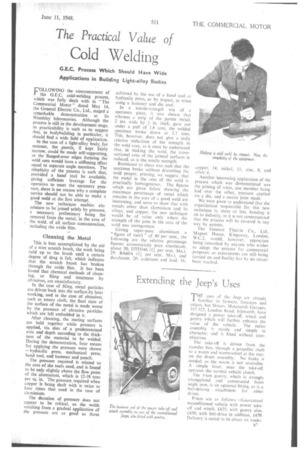The Practical Value of
Page 41

If you've noticed an error in this article please click here to report it so we can fix it.
Cold Welding
G.E.C. Process Which Should Have Wide Applications in Building Light-alloy Bodies VOLLOWING the announcement of I -the G.E.C. cold-welding process, which was fully dealt with in "The Commercial Motor" dated May 14, the General Electric Co„ Ltd., staged a remarkable demonstration at its Wembley laboratories. Although the process is still in the development stage, its practicability is such as to suggest that, in bodybuilding in particular, it should find a wide field of application.
In the case of a light-alloy body, for instance, the panels, if kept fairly narrow, could be made self-supporting, as the flanged-over edges forming the weld area would have a stiffening effect equal to separate angle members. The simplicity of the process is such that, provided a hand tool be available, giving sufficient leverage for the operative to exert the necessary pressure, there is no reason why a complete novice should not be able to make a good weld at the first attempt.
The new technique enables aluminium to be joinedsolely by pressure, a necessary preliminary being the removal from the metal, in the area of the weld, of all surface contamination, including the oxide film.
Cleaning the Metal This is best accomplished by the aid of a wire scratch brush, the work being held up to the brush until a certain degree of drag is felt, which indicates that the scratch brush has broken through the oxide film. It has been found that chemical methods of cleaning, or filing and treatment by abrasives, are unsatisfactory.
In the case of filing, metal particles are driven back into the surface.by later working, and in the case of abrasives, such as emery cloth, the final state of the surface of the metal is made Worse by the presence of abrasive particles which are left embedded in it.
After cleaning, the mating surfaces are held together while pressure is applied, via dies of a predetermined area and depth according to the thickness of the material to be welded. During the demonstration, four means for applying the pressure were shown —hydraulic press, mechanical press, hand tool, and hammer and punch.
The pressure required is related to the area of the tools used, and is found to be only slightly above the flow point of the aluminium, which is 12-18 tons per sq. in. The pressure required when copper is being dealt with is twice to four times that used in the case of aluminium.
The duration of pressure does not appear to be critical. as the welds resulting from a gradual application of the pressure are as good as those
achieved by the use of a hand tool or hydraulic press, or by impact, as when using a hammer and die tool.
In a tensile-strength test of a Specimen piece, it was shown that whereas a strip of the parent metal,
2 ins, wide by in. thick, gave out under a pull of 1.8 tons, the welded specimen broke down at 1.7 tons. This, however, does not give a truly relative indication of the strength in the weld area, as it must be understood that, in making the weld, the crosssectional area of the jointed surfaces is reduced, as is the tensile strength.
Resistance to shear was such that the specimen broke without disturbing the weld proper, proving, we suggest, that the metal in the area of the weld is practically homogeneous. The figures which are given below showing the maximum percentage of metal which remains in the area of a good weld are interesting, and serve to show that with metals other than aluminium and its alloys, and copper, the new technique would be of value only where the strength of the joint in the area of the weld was unimportant.
Giving super-pure aluminium a "figure of merit" of 40 per cent., the following are the relative percentage figures: commercially pure aluminium, about 30; DTD346 (VI per cent. Mn.), 29; BA60A (11 per cent. Mn.). and duralumin, 20: cadmium and lead, 16: copper, 14; nickel, 11; zinc, 8, and silver 6.
Another interesting application of the process which was demonstrated was the joining of wires, one member being laid over the other, pressure applied via a die, and a secure joint made.
We were given to understand that the organization responsible for this new technique is, more or less, handing it on to industry, as it is not contemplated that the process will be covered in any way by patents.
The General Electric Co., Ltd., Magnet Rouse, Kingsway, London, W.C.2, would, however, appreciate being consulted by anyone who wishes to adopt the process for commercial purposes, as experiments are still being carried on and finality has by no means been reached.




















































































